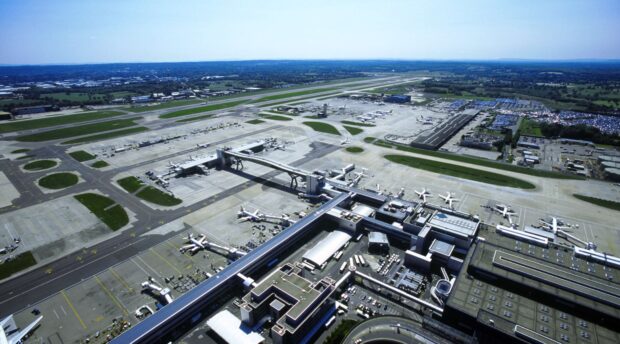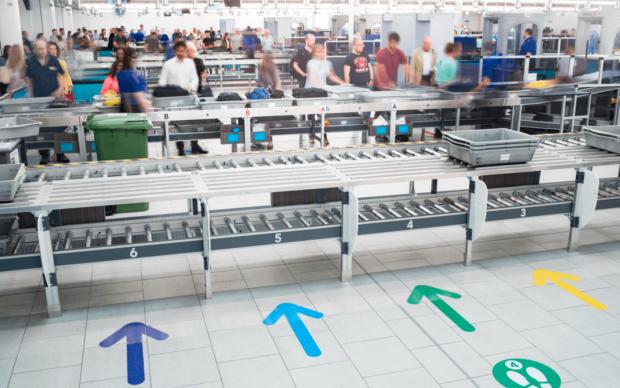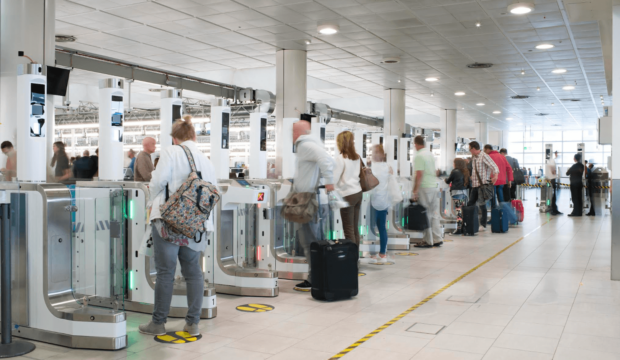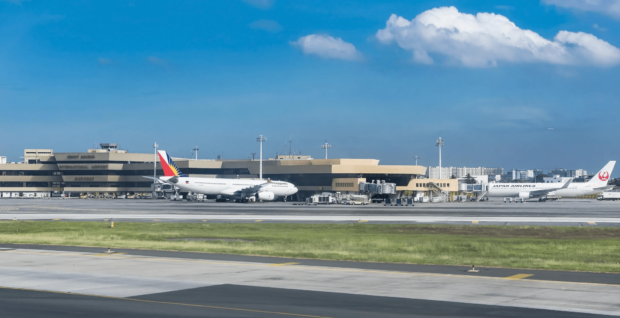NAIA upgrade- critical to support tourism, economic growth
NAIA’s role as the primary gateway to the country cannot be overstated: about 80% of all scheduled international and domestic air passengers pass through its halls. As such, it is a major enabler of inbound tourism, which represents 12.9% of local GDP and 13.6% of total local employment. Further, travel and tourism sectors, which currently account for 22.5% of gross domestic product (GDP), are poised to become an even bigger growth driver as the Philippines looks to transform itself into a regional powerhouse after the pandemic.
With travel demand already rebounding and expected to recover to pre-pandemic levels by 2024, strains and challenges have recently begun to crop up at NAIA, which have impacted passenger experience and airline service quality.

London Gatwick Airport North Terminal Airfield
To address Metro Manila’s growing aviation needs, plans have been drafted to develop multiple airports in nearby provinces, including greenfield developments. While these will help address congestion and load issues over the long term, these should be done in parallel with the immediate rehabilitation of NAIA. Any major metropolitan city over 20 million people always has more than 2 airports to ensure it can meet air traffic demand and withstand shocks and one-off interruptions. In particular, Metro Manilla air traffic demand is expected to exceed over 100 million passengers per year within a little more than ten years from now.
“NAIA is currently the only large-scale operating airport currently serving Metro Manila and it has an ecosystem of supporting infrastructure that would take decades to replicate,” shares Kevin Tan, CEO of Alliance Global Group and a member of the Manila International Airport Consortium (MIAC), a partnership among six leading Filipino conglomerates and US-based Global Infrastructure Partners (GIP) which submitted an unsolicited proposal to the Philippine Government in April this year for the upgrading of NAIA.
“Therefore, it is imperative to rehabilitate and expand NAIA, which we believe will still play a central and critical role even as Metro Manila expands its airport network,” Mr. Kevin Tan added.
He adds that the rehabilitation of NAIA will not invalidate the rationale for expanding the airport ecosystem serving Metro Manila as, given the region’s size and disaster-prone nature, it actually needs redundancies much like similar cities such as London, Seoul, and Tokyo, and several other capital cities in the world.

London Gatwick Airport Next Generation Security Lanes
Moreover, NAIA’s cross runway feature is not the capacity constraint some paint it out to be if developed to world class standards by an experienced operator. Philip Iley, GIP Partners and Head of Transport who sits on the Board of Gatwick cites London’s Gatwick Airport as a prime example. Global Infrastructure Partners, its main operator and owner for more than a decade and one of the partners in the MIAC consortium, has been able to optimize Gatwick’s sole runway to increase peak air traffic movements (ATMs) to 55 per hour, with a plan to increase to 60. NAIA’s runway capacity is currently declared at 41 ATMs per hour.
Recognizing the important role that NAIA plays in the growth of the country’s tourism and economy, members of the MIAC have banded together with the shared vision of upgrading and transforming NAIA into a world-class airport.
Apart from GIP, others partners in the consortium include six of the largest Filipino conglomerates: Aboitiz InfraCapital, Inc., AC Infrastructure Holdings Corporation, Asia’s Emerging Dragon Corporation, Alliance Global – Infracorp Development Inc., Filinvest Development Corporation, and JG Summit Infrastructure Holdings Corporation.
Together, the consortium has unparalleled scale, track record, resources, and expertise to deliver best-in-class solutions for the transformation of NAIA and aim to set the country’s airport infrastructure up for success in line with the government’s “Build, Better, More” program. Airports currently and previously owned or operated by members of the Consortium include Mactan-Cebu, Clark, London Gatwick, Edinburgh, London City and Sydney airports.
In its proposal, the Consortium proposes a total project cost of PHP 210 billion. This covers approximately US$ 1 billion of capital investments over the first five years, and an investment of another projected US$2.8 billion over the remainder of its proposed 25-year concession period. This investment will be geared toward undertaking facility upgrades, maintenance work, implementing new operating processes, and introducing new technologies which will increase passenger capacity, shorten waiting and processing times, introduce more comfortable and modern facilities, and provide better connectivity between terminals, among others.
The Consortium’s proposal also includes an unprecedented US$ 1 billion concession payment to the government—the largest ever concession payment offered for a transportation PPP project, whether solicited or unsolicited.
“We believe that an upfront payment now to the government can potentially contribute to the country’s response to fiscal challenges due to the economic impact of the COVID-19 pandemic and current tightening global financial conditions. It would also allow the government to redeploy some of the funds into provincial projects that are in urgent need of funding,” says Cosette Canilao, President and CEO of Aboitiz InfraCapital, Inc. and a Director of the Consortium. “It provides immediate value and impact that is worth more than any mulled or pending plans to redevelop NAIA land.”
Apart from the concession payment, the government is set to derive additional revenue from revenue sharing as well as through business and other taxes.
Over-all, MIAC’s proposal is projected to create US$ 14.6 billion worth of direct and indirect economic value throughout its proposed concession period while boosting regional trade, foreign investment, local commerce, and inbound tourism.
According to MIAC, its proposal presents a fair, transparent, and fast route to deliver the much-needed improvements to NAIA under a public-private partnership (PPP) framework—and one that provides numerous benefits to all stakeholders involved—including passengers, the government, and the greater public.
Sabin Aboitiz, CEO of the Aboitiz Group of Companies, adds, “It is our hope to partner with the government and deliver to Filipinos the NAIA they deserve, now. We are confident to deliver a significantly improved passenger experience in the very near term. We are here and ready to make NAIA the engine of growth for the country’s tourism industry and economy”
MIAC’s Envisioned New NAIA to Maximize Value for Filipinos
Transforming NAIA to meet the growing demands of post-pandemic air travel growth in the long run is an immense task. The Manila International Airport Consortium (MIAC) is determined to realize a grand vision for the airport with a fair, transparent, and comprehensive turnkey project proposal.
Public-Private Partnerships (PPP) are widely used all over the world as a means of delivering public infrastructure, due to the numerous benefits they offer to governments. These advantages include efficiency in service delivery, innovation, access to private capital, cost savings, and – in MIAC’s proposal – revenue sharing and additional investment opportunities.

London Gatwick Airport Automated Boarding Gates
MIAC’s proposal for a 25-year concession of NAIA, is not a privatization of the airport, since there is no permanent transfer of assets to the private sector, and the Government retains ultimate ownership. The Consortium proposal strictly adheres to the implementing rules and regulations of the Build-Operate-Transfer Law, and categorically contains no government guarantees. This is currently the fastest route on-hand for realizing the long-sought-after modernization of NAIA. Given the strength of the consortium and their resources and expertise combined with the attractiveness of the proposal, the government has an option that can be concluded this year where results can start to be delivered in 2024.
To ensure the long-term sustainability of the project, foster meaningful private sector participation and ensure the significant investment required to transform NAIA can be secured, a 25-year concession period is crucial. In contrast to shorter concession terms, a 25-year concession allows for extensive planning and development of the airport, enabling significant enhancements in the quality of service offered to passengers and airlines.
Elevating NAIA to a world-class standard and maximizing its potential capacity requires sustained capital and long-term planning. A 25-year concession period allows the private sector to invest accordingly in the airport’s infrastructure and technology, which will further enhance its potential. Through significant capital investment and implementation of new operating processes and efficiencies that the Consortium is proposing, NAIA will be able to serve up to approximately 63 million passengers per annum by 2028, and up to approximately 70 million passengers per annum in the long term, more than double its current capacity.
Given the significant amount of capital investments required for the transformation of NAIA under the MIAC proposal (Proposal), a 25-year concession period will allow the Consortium to recoup its investment slowly and provide sufficient time to institutionalize the superior level of service expected of the international gateway. Furthermore, such a decision will showcase the government’s commitment to attract strong foreign and local players for future PPP projects.
NAIA is strategically located in the heart of the Philippines, making it the most important gateway for both domestic and international travelers. A 25-year concession period is well-suited to ensure the airport’s ongoing operational efficiency, seamless service continuity, and alignment with the nation’s interests.
Besides these long-term value points, the Proposal’s immediate positive impact cannot be overlooked. The Consortium’s US$ 1 billion concession payment is the largest ever concession payment offered for a transportation PPP project in the country, whether solicited or unsolicited. This gives the government substantial fiscal capability to meet the ongoing pandemic recovery efforts, address the growing consumer demands for safer, more convenient and efficient travel services, and help the country face challenging global economic conditions.
The government is expected to further benefit from a revenue sharing arrangement with the Consortium during the concession period, which is estimated to be in excess of US$ 1 billion. This will provide much needed funding for the government to invest in improving other commercially challenging airports in the country, allowing for the efficient recycling of capital for the benefit of the public. The Consortium is projected to drive direct and indirect economic value amounting to US$14.6bn in total.
In addition, the NAIA PPP will present an attractive investment case for other investors – domestic and foreign – to participate in meaningful and viable projects with the government. This will result in more competitive bids from private sector companies, and lead to better outcomes for the government.

NAIA Runaway and T1 Building
For all of these reasons, MIAC’s Proposal stands as a strong, viable and advantageous choice for the rehabilitation and transformation of NAIA. What adds further appeal to the Proposal even more attractive is the safeguards in place to maintain transparency and legitimacy for the benefit of the government. Notably, the Proposal does not seek any form of government guarantees. Furthermore, it provides the government with flexibility to terminate the concession after Year 15, should alternative use of the airport’s space prove to be more valuable at that point in time.
Given the pressing urgency of the need and the strategic importance of this undertaking, it would be in the government’s best interest to embrace the Proposal’s immediate and future benefits by entrusting NAIA to an experienced operator. MIAC comprises some of the country’s largest and most successful conglomerates, possessing extensive expertise and track record in operating and successfully delivering large infrastructure projects in air travel, rail transportation, and other vital public services.
Their US-based partner, Global Infrastructure Partners (GIP), is one of the leading infrastructure investors and airport operators in the world. The firm has over US$ 89 billion of assets under management in infrastructure companies that generate more than US$80 billion of annual revenues globally. GIP has successfully owned, operated and improved airports for over 16 years, with a portfolio that includes London Gatwick, Edinburgh, London City and Sydney airports. Of note, GIP’s Chairman currently is the Chair of President Biden’s National Infrastructure Advisory Council in the United States, and GIP was the only infrastructure investor invited to present to the G7 Summit leaders in Japan earlier this year to discuss infrastructure development in developing markets.
With a combination of local and international capacity, along with a proven track record, MIAC possesses the necessary expertise and substantial financial resources to effectively deliver its proposal to transform NAIA. -by AC
Manila International Airport Consortium offers global expertise and strong track record
A Closer Look at the Members of the MIAC and what they see for the future of the NAIA
The Manila International Airport Consortium (MIAC) is a matchless partnership between some of the largest and most successful Philippine Conglomerates, and Global Infrastructure Partners (GIP), a leading global infrastructure investor and airport operator.
The local consortium members include Aboitiz InfraCapital, Inc., AC Infrastructure Holdings Corporation, Asia’s Emerging Dragon Corporation, Alliance Global – Infracorp Development, Inc., Filinvest Development Corporation, and JG Summit Infrastructure Holdings Corporation. These titans have an extensive track record in operating and delivering household names in air transportation such as the Mactan Cebu International Airport, Clark International Airport, Philippine Airlines and Cebu Pacific.
Furthermore, the consortium offers global expertise and track record through its technical partner, GIP. GIP has over 16 years of track record in investing in and operating airports and is one of the largest and most credible airport operators globally with over 100 million passengers served annually at its airports. GIP also brings with it a unique focus on infrastructure management best-practices and experience in delivering large-scale investment program and service level improvements. Among the airports that the GIP manages and oversees are; London Gatwick Airport, the number 2 airport in the UK, which serves around 47 million passengers per year; Edinburgh Airport, the number 1 airport in Scotland with roughly 14 million passengers per year; and Sydney Airport, the number 1 airport in Australia with about 44 million passengers annually.
Currently, NAIA runways can only service 41 aircraft take-offs or landings per hour (Air Transport Movements per hour or ATMs/hour) at its peak. As NAIA’s runways are intersecting, only one can be utilized at a time, effectively making NAIA a single runway operation. Since airport capacity is determined not only by its size but also by its runway capacity, many have pointed to NAIA’s two intersecting runways as an inherent constraint which puts a cap on NAIA’s future growth.
However, this preconceived limitation of an intersecting runway is shattered by GIP’s London Gatwick Airport, the world’s busiest single-runway airport. Within five years of taking over operations, GIP has improved Gatwick’s runway capacity from its previous 50 ATMs/hour to 55 ATMs/hour demonstrating the potential of NAIA’s current runway configuration. While NAIA has a comparable terminal footprint and the benefit of two runways, its declared peak capacity of 41 ATMs/hour is 25% lower; indicating that there is, in fact, room for its growth.
In spite of new air transport projects in development in the surrounding areas, NAIA’s existing supporting infrastructure and commercial ecosystem keeps it a key feature within the Manila Airport System. As passenger traffic in the Manila Airport System is growing rapidly and reaching 141 MPPA by 2048, it is crucial that the Philippines protects and develops a multi-airport approach to meet these needs.
We look to the examples of cities with similar, if not fewer populations who benefit from the operations of multiple airports including; Tokyo, with the Tokyo International Airport and the Narita International Airport servicing its 41 million population; Seoul with Incheon International Airport and Gimpo International Airport catering to its 26 million population; or New York where its 20 million passengers can choose among JFK International Airport, LaGuardia Airport or Newark Liberty International Airport.
Similarly, NAIA has a future primed to remain a thriving part of the network that will serve Metro Manila, especially with potential climate-driven or natural disasters that could impede and shutdown airports in the country. It is imperative to ensure the country has one strong, reliable and safe airport, as new airport developments progress over the coming decades.
MIAC is committed to putting its combined resources forward in partnering with the Government on this massive undertaking of designing and developing a modern and sustainable NAIA – one that is world-class and befitting the Philippines and its people. With its Proposal, the MIAC hopes to turn these future possibilities for the NAIA, into reality. The exciting part: they have the experience, resources, and ability to act now and start to deliver results for the much needed airport transformation. -by AC
ADVT.